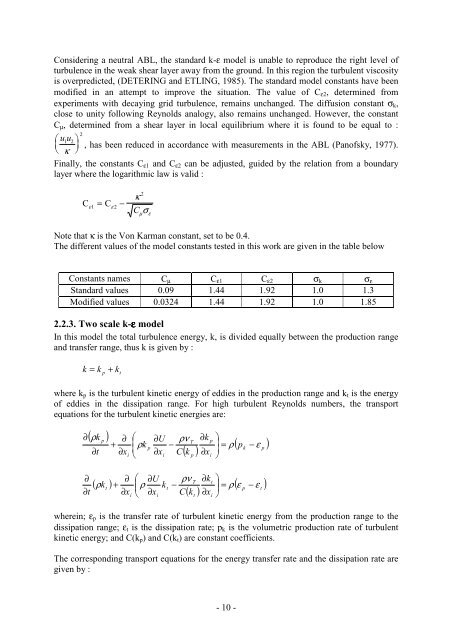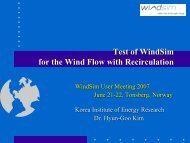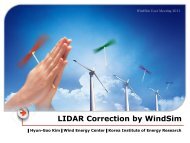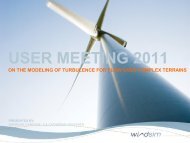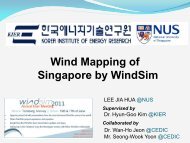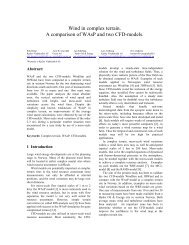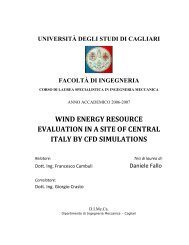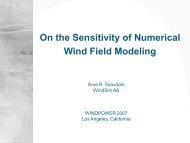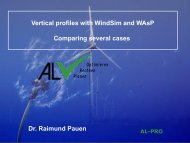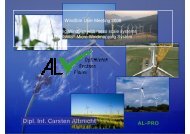Wind field simulations at Askervein hill - WindSim
Wind field simulations at Askervein hill - WindSim
Wind field simulations at Askervein hill - WindSim
You also want an ePaper? Increase the reach of your titles
YUMPU automatically turns print PDFs into web optimized ePapers that Google loves.
Considering a neutral ABL, the standard k-ε model is unable to reproduce the right level of<br />
turbulence in the weak shear layer away from the ground. In this region the turbulent viscosity<br />
is overpredicted, (DETERING and ETLING, 1985). The standard model constants have been<br />
modified in an <strong>at</strong>tempt to improve the situ<strong>at</strong>ion. The value of C ε2 , determined from<br />
experiments with decaying grid turbulence, remains unchanged. The diffusion constant σ k ,<br />
close to unity following Reynolds analogy, also remains unchanged. However, the constant<br />
C µ , determined from a shear layer in local equilibrium where it is found to be equal to :<br />
2<br />
⎛ u 1<br />
u 2 ⎞<br />
⎜ ⎟ , has been reduced in accordance with measurements in the ABL (Panofsky, 1977).<br />
⎝ κ ⎠<br />
Finally, the constants C ε1 and C ε2 can be adjusted, guided by the rel<strong>at</strong>ion from a boundary<br />
layer where the logarithmic law is valid :<br />
C<br />
2<br />
κ<br />
= Cε<br />
− C σ<br />
ε1 2<br />
µ ε<br />
Note th<strong>at</strong> κ is the Von Karman constant, set to be 0.4.<br />
The different values of the model constants tested in this work are given in the table below<br />
Constants names C µ C ε1 C ε2 σ k σ ε<br />
Standard values 0.09 1.44 1.92 1.0 1.3<br />
Modified values 0.0324 1.44 1.92 1.0 1.85<br />
2.2.3. Two scale k-ε model<br />
In this model the total turbulence energy, k, is divided equally between the production range<br />
and transfer range, thus k is given by :<br />
k = k p<br />
+ k t<br />
where k p is the turbulent kinetic energy of eddies in the production range and k t is the energy<br />
of eddies in the dissip<strong>at</strong>ion range. For high turbulent Reynolds numbers, the transport<br />
equ<strong>at</strong>ions for the turbulent kinetic energies are:<br />
∂<br />
( ρk<br />
)<br />
∂t<br />
p<br />
∂<br />
+<br />
∂x<br />
i<br />
⎛<br />
⎜ ρk<br />
⎝<br />
p<br />
∂U<br />
∂x<br />
i<br />
ρν<br />
T<br />
−<br />
C<br />
( k )<br />
p<br />
∂k<br />
∂x<br />
p<br />
i<br />
⎞<br />
⎟ = ρ<br />
⎠<br />
( p − ε )<br />
k<br />
p<br />
∂<br />
∂t<br />
( ρk<br />
)<br />
t<br />
∂<br />
+<br />
∂x<br />
i<br />
⎛ ∂U<br />
⎜ ρ<br />
⎝ ∂xi<br />
k<br />
t<br />
ρν<br />
T<br />
−<br />
C<br />
( k )<br />
t<br />
∂k<br />
t<br />
∂x<br />
i<br />
⎞<br />
⎟ = ρ<br />
⎠<br />
( ε − ε )<br />
p<br />
t<br />
wherein; ε p is the transfer r<strong>at</strong>e of turbulent kinetic energy from the production range to the<br />
dissip<strong>at</strong>ion range; ε t is the dissip<strong>at</strong>ion r<strong>at</strong>e; p k is the volumetric production r<strong>at</strong>e of turbulent<br />
kinetic energy; and C(k p ) and C(k t ) are constant coefficients.<br />
The corresponding transport equ<strong>at</strong>ions for the energy transfer r<strong>at</strong>e and the dissip<strong>at</strong>ion r<strong>at</strong>e are<br />
given by :<br />
- 10 -


